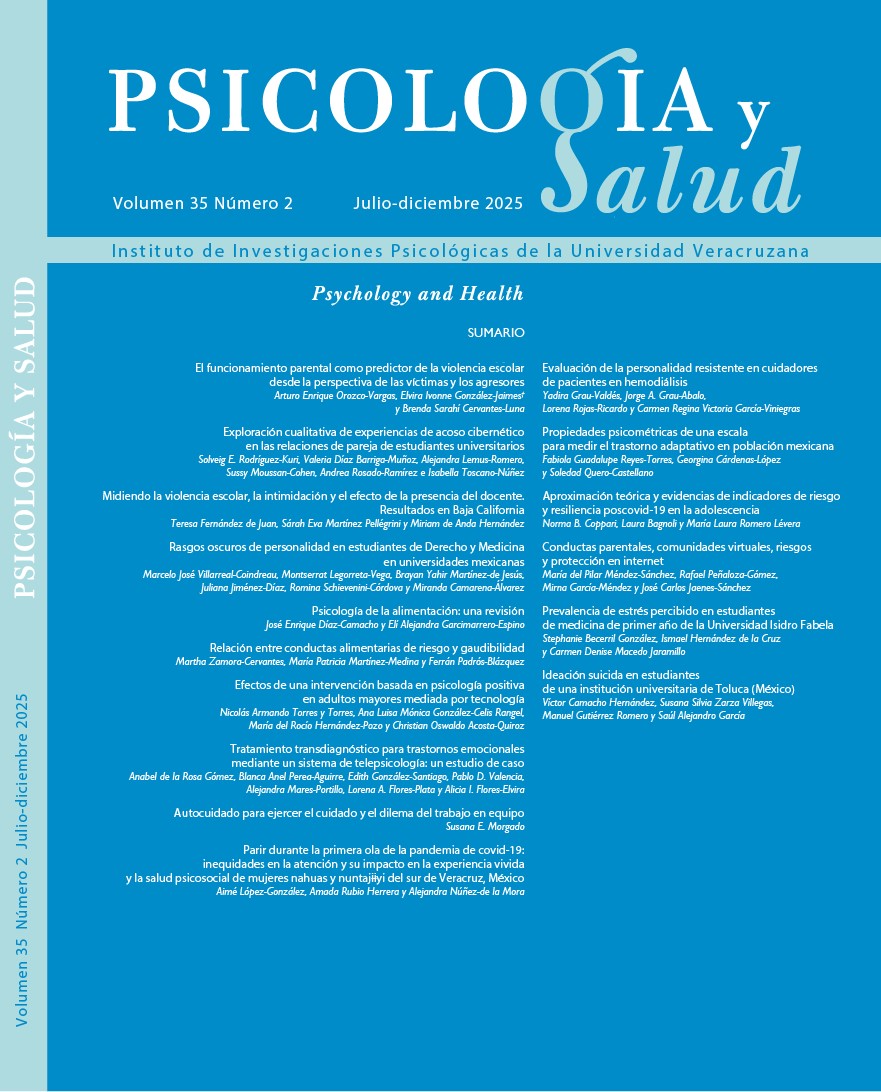Abstract
Humans need to eat to produce the energy necessary for the organism's primary survival activities and functions: feeding activities, activation of the nervous system and skeletal muscles, moving, working, and other daily activities. Feeding is an activity common to all species on the phylogenetic scale. However, food selection, quality, and quantity are not always adequate; errors frequently result in bad habits and emotional disorders that do not allow adequate dietary planning, causing nutritional and psychological problems and leading to serious public health problems. The present paper reviews experimental studies that trigger compulsive behaviors caused by emotional states as well as the most common health problems, among which collective physical and mental health issues stand out.
References
Arreguín, R., Sandoval, S. y González, J. (2016). Preocupación por la apariencia física en usuarios de empresas multideportivas en México. Revista de Psicología del Deporte, 25(2), 329-337.
Banco Mundial (2015). Informe Anual. Washington D. C.: Banco Mundial. Consultado en http://www.bancomundial.org/projects recuperado el 6/5/2023
Behar, A. (2010). La construcción cultural del cuerpo: El paradigma de los trastornos de la conducta alimentaria. Revista Chilena de Neuropsicología, 48(4), 319-334. Recuperado de https://www.redalyc.org/articulo.oa?id=331527722007
Bouzas, A. y Baum, W. M. (1976). Behavioral contrast of time allocation. Journal of the Experimental Analysis of Behavior, 25(2), 179-184. Doi: 10.1901/jeab.1976.25-179
Brea, A. (2019). Corporalidad online-offline: Revisión sistemática de la influencia de Instagram en la imagen corporal de los adolescentes. Tesis inédita de maestría. Barcelona: Universidad Autónoma de Barcelona.
Colotla, V.A., Keehn, J.D. y Gardner, L.L. (1970). Control of schedule-induced drink durations by inter-pellet intervals. Psychonomic Science, 21, 137-139.
Falk, J.L. (1961). Production of polydipsia in normal rats by an intermittent food schedule. Science, 133, 195-196.
Falk, J.L. (1966a). The motivational properties of schedule-induced polydipsia. Journal of the Experimental Analysis of Behavior, 9, 19-25.
Falk, J.L. (1966b). Schedule-induced polydipsia as a function of fixed-interval length. Journal of the Experimental Analysis of Behavior, 9, 37-39.
Falk, J.L. (1967). Control of schedule-induced polydipsia: type, size, and spacing of meals. Journal of the Experimental Analysis of Behavior, 10, 199-206.
Flores, B. (2018). Insatisfacción con la imagen corporal, conductas alimentarias de riesgo y deseo de modificación corporal en adolescentes: un reporte por sexo y orientación sexual en Hermosillo, Sonora. Tesis de Maestría. Tijuana (México): Colegio de la Frontera Norte. Recuperado de https://www.colef.mx/posgrado/tesis/20161293/
Fox, J., Megan, A. y Vendemia, M. (2016). Selective self-presentation and social comparison through photographs on social networking sites. School of Communication, 19(10), 593-599. Doi: 10.1089/cyber.2016.0248
Hollander, R., Cohen, L. y Simeon, D. (1993). Body dysphoric disorder. Psychiatric Annals, 23(7), 359-364. Doi: 10.3928/0048-5713-19930701-06
Instituto Nacional de Salud Pública (2013). Obesidad, diabetes y enfermedades cardiovasculares. Cuernavaca (México): Recuperado de http://www.insp.mx/lineas-de-investigacion/obesidad-diabetes-y-enfermedades-cardiovasculares.html
Killeen, P.R. (2014). A theory of behavioral contrast. Journal of the Experimental Analysis of Behavior, 102(3), 363-390.
Martínez F., C.L. (2022). Relación entre el uso de Instagram y la comparación social con respecto a la satisfacción corporal y la ansiedad por apariencia física en universitarios. Tesis inédita de Licenciatura. Xalapa (México): Universidad Veracruzana.
Moreno, B. (2021). Autoestima en la actualidad: ¿cómo afectan las redes sociales? Tesis inédita de Licenciatura. Madrid: Universidad Pontificia Comillas. Recuperado de https://repositorio.comillas.edu/xmlui/handle/11531/50905
Palomino P., A.M. (2020). Rol de la emoción en la conducta alimentaria. Revista Chilena de Nutrición, 47(2), 286-291.
Panamerican Health Organization / World Health Organization (2018). Non-communicable diseases. Santiago de Chile: PHO/WHO. Available from https://www.paho.org/chi/index.php?option=com_contentyview=articleyid=128:enfermedades-no-transmisiblesyItemid=213 4
Pavlov, I.P. (1891). Conditioned reflexes: an investigation of the physiological activity of the cerebral cortex (Translated and edited by G.V. Anrep). New York: Dover Publications.
Sidman, H. y Stoddard, L.T. (1967). The effectiveness of fading in programming a simultaneous form discrimination for retarded children. Journal of the Experimental Analysis of Behavior, 10, 3-15.
Talbot, D. y Mahlberg, J. (2023). Exploration of height dissatisfaction, muscle dissatisfaction, body ideals, and eating disorder symptoms in men. Journal of American College Health, 71(1), 18-23.
Terrace, H.S. (1963). Discrimination learning with and without “errors”. Journal of the Experimental Analysis of Behavior, 6, 1-27.
Terrace, H.S. (1964). Wavelength generalization after discrimination learning with and without errors. Science, 144(3614), 78-80. Doi: 10.1126/science.144.3614.78
Terrace, H.S. (1966a). Discrimination learning and inhibition. Science, 154, 1677-1680.
Terrace, H.S. (1966b). Behavioral contrast and the peak shift: effects of extended discrimination training. Journal of the Experimental Analysis of Behavior, 6, 613-617.
Terrace, H.S. (1966c). Stimulus control. En W. K. Honig (Ed.): Operant behavior: Areas of research and application (pp. 271-344). New York: Appleton-Century-Crofts.
Tiggemann, M. y Zaccardo, M. (2018). Strong is the new skinny: A content analysis of fitspiration images on Instagram. Journal of Health Psychology, 23(8), 1003-1011. Doi: 10.1177/1359105316639436
Williams, H., Mesidor, M., Winters, K., Dubbert, P. y Wyatt, S. (2015). Overweight and obesity: Prevalence, consequences and causes of a growing public health problem. Current Obesity Reports, 4(3), 363-370.


